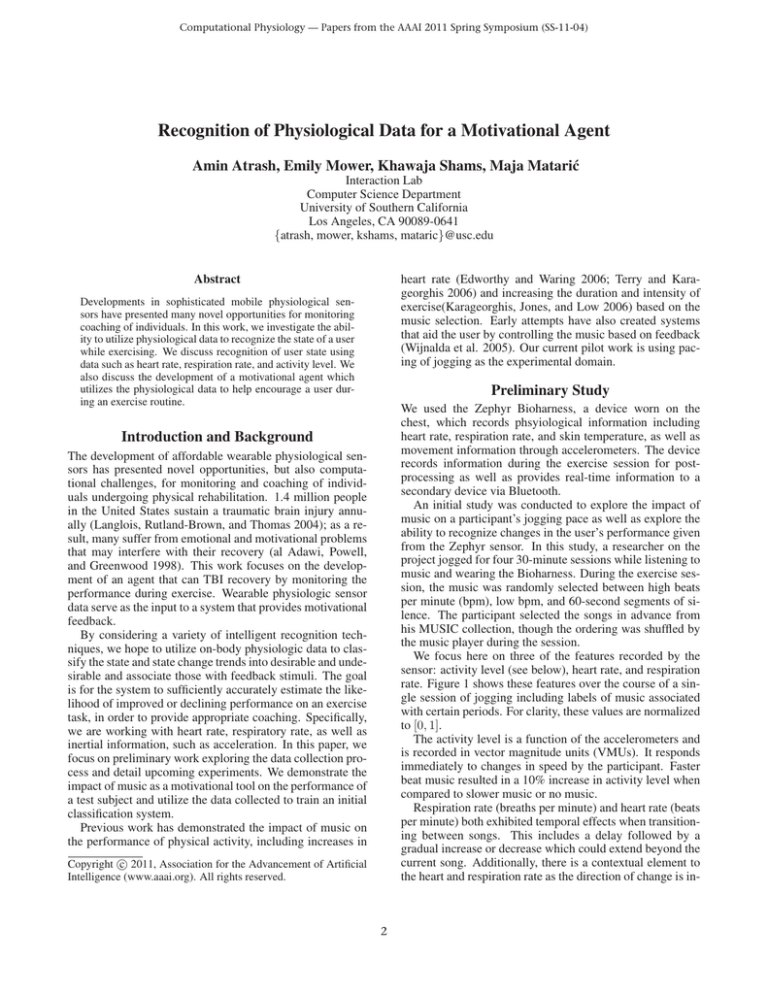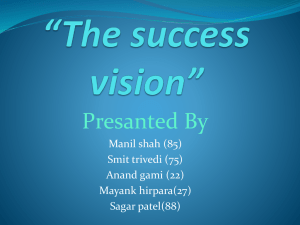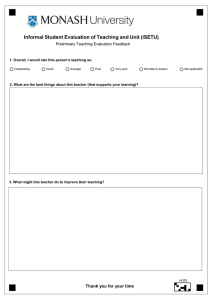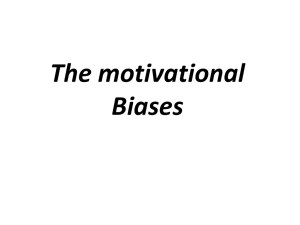
Computational Physiology — Papers from the AAAI 2011 Spring Symposium (SS-11-04)
Recognition of Physiological Data for a Motivational Agent
Amin Atrash, Emily Mower, Khawaja Shams, Maja Matarić
Interaction Lab
Computer Science Department
University of Southern California
Los Angeles, CA 90089-0641
{atrash, mower, kshams, mataric}@usc.edu
heart rate (Edworthy and Waring 2006; Terry and Karageorghis 2006) and increasing the duration and intensity of
exercise(Karageorghis, Jones, and Low 2006) based on the
music selection. Early attempts have also created systems
that aid the user by controlling the music based on feedback
(Wijnalda et al. 2005). Our current pilot work is using pacing of jogging as the experimental domain.
Abstract
Developments in sophisticated mobile physiological sensors have presented many novel opportunities for monitoring
coaching of individuals. In this work, we investigate the ability to utilize physiological data to recognize the state of a user
while exercising. We discuss recognition of user state using
data such as heart rate, respiration rate, and activity level. We
also discuss the development of a motivational agent which
utilizes the physiological data to help encourage a user during an exercise routine.
Preliminary Study
We used the Zephyr Bioharness, a device worn on the
chest, which records phsyiological information including
heart rate, respiration rate, and skin temperature, as well as
movement information through accelerometers. The device
records information during the exercise session for postprocessing as well as provides real-time information to a
secondary device via Bluetooth.
An initial study was conducted to explore the impact of
music on a participant’s jogging pace as well as explore the
ability to recognize changes in the user’s performance given
from the Zephyr sensor. In this study, a researcher on the
project jogged for four 30-minute sessions while listening to
music and wearing the Bioharness. During the exercise session, the music was randomly selected between high beats
per minute (bpm), low bpm, and 60-second segments of silence. The participant selected the songs in advance from
his MUSIC collection, though the ordering was shuffled by
the music player during the session.
We focus here on three of the features recorded by the
sensor: activity level (see below), heart rate, and respiration
rate. Figure 1 shows these features over the course of a single session of jogging including labels of music associated
with certain periods. For clarity, these values are normalized
to [0, 1].
The activity level is a function of the accelerometers and
is recorded in vector magnitude units (VMUs). It responds
immediately to changes in speed by the participant. Faster
beat music resulted in a 10% increase in activity level when
compared to slower music or no music.
Respiration rate (breaths per minute) and heart rate (beats
per minute) both exhibited temporal effects when transitioning between songs. This includes a delay followed by a
gradual increase or decrease which could extend beyond the
current song. Additionally, there is a contextual element to
the heart and respiration rate as the direction of change is in-
Introduction and Background
The development of affordable wearable physiological sensors has presented novel opportunities, but also computational challenges, for monitoring and coaching of individuals undergoing physical rehabilitation. 1.4 million people
in the United States sustain a traumatic brain injury annually (Langlois, Rutland-Brown, and Thomas 2004); as a result, many suffer from emotional and motivational problems
that may interfere with their recovery (al Adawi, Powell,
and Greenwood 1998). This work focuses on the development of an agent that can TBI recovery by monitoring the
performance during exercise. Wearable physiologic sensor
data serve as the input to a system that provides motivational
feedback.
By considering a variety of intelligent recognition techniques, we hope to utilize on-body physiologic data to classify the state and state change trends into desirable and undesirable and associate those with feedback stimuli. The goal
is for the system to sufficiently accurately estimate the likelihood of improved or declining performance on an exercise
task, in order to provide appropriate coaching. Specifically,
we are working with heart rate, respiratory rate, as well as
inertial information, such as acceleration. In this paper, we
focus on preliminary work exploring the data collection process and detail upcoming experiments. We demonstrate the
impact of music as a motivational tool on the performance of
a test subject and utilize the data collected to train an initial
classification system.
Previous work has demonstrated the impact of music on
the performance of physical activity, including increases in
c 2011, Association for the Advancement of Artificial
Copyright Intelligence (www.aaai.org). All rights reserved.
2
Figure 1: Example data from a 30 minute jogging session
fluenced by the the previous exersion level. In many cases, it
was also observed that both of these rates tended to increase
significantly after a song when the user slowed to a walk to
rest. This corresponded to the user controlling his breathing
while jogging but recovering while walking.
We examine the ability to recognize the user’s exertion
level using the data from the sensor. For this preliminary
work, we disregarded the temporal aspect of the data. Additionally, we found that performance with slow music was
not significantly different than with no music. Thus, we
attempted to recognize two classes: low exertion and high
exertion. The data were labelled based on ground truth
recorded by the subject. A naive Bayesian classifier was
trained on the resulting data. Using a random subset crossvalidation approach, the classifier was able to correctly classify the low exertion points with 81% accuracy and the high
exertion points with 87% accuracy, with an overall accuracy
of 84%.
asked to maintain an exericse routine for several weeks, with
and without the aid of the agent. This phase will take advantage of the data for action selection, selecting the correct
must based on the current state of the participant.
Finally, although these initial studies center around
healthy participants, the insights will act as a baseline for
future studies with individuals with traumatic brain injury
and other cognitive impairments.
Acknowledgements
This work was supported by Intelligent Automation, Inc.
and the Office of the Secretary of Defense grant W81XWH09-C-0134.
References
al Adawi, S.; Powell, J.; and Greenwood, R. 1998. Motivational
deficits after brain injury: a neuropsychological approach using
new assessment techniques. Neuropsychology 12(1):115–124.
Edworthy, J., and Waring, H. 2006. The effects of music tempo
and loudness level on treadmill exercise. Ergonomics 49(15):1597–
1610.
Karageorghis, C.; Jones, L.; and Low, D. 2006. Relationship between exercise heart rate and music tempo preference. Research
Quarterly for Exercise and Sport 77(2):240–250.
Langlois, J.; Rutland-Brown, W.; and Thomas, K. 2004. Traumatic brain injury in the united states: Emergency department visits, hospitalizations, and deaths. Technical report, Centers for Disease Control and Prevention, National Center for Injury Prevention
and Control.
Rabiner, L. R. 1990. A tutorial on hidden Markov models and
selected applications in speech recognition. In Readings in Speech
Recognition, 267–296.
Terry, P., and Karageorghis, C. 2006. Psycholophysical effects
if music in sport and exercise: an update on theory, research, and
application. In Joint Conference of the Australian Psychological
Society and the New Zealand Pscyhological Society, 415–419.
Wijnalda, G.; Pauws, S.; Vignoli, F.; and Stuckenschmidt, H. 2005.
A personalized music system for motivation in sport performance.
IEEE Pervasive Computing 4(3):26–32.
Future Work
The study described in this paper represents a preliminary
exploratory experiment to examine the capabilities of the
sensor in relation to music. The study focused on a singleuser test case.
This preliminary study leads to many improvements to be
pursued. One of the most important is to incorporate the
temporal component of the data into the analysis and classification. The naive Bayes approach does not capture the
temporal component.
Our future work will look into using Hidden Markov
Models (HMMs) (Rabiner 1990) for recognition, among
other approaches..
The next phase in this work will also expand to collect
data from larger groups to account for data diversity and statistical significance. Participants will be asked to jog around
a track while listening to selected music. Under this study,
music will be selected by the researchers. Data will be
record and analyzed in a fashion similar to the preliminary
experiment.
A second study will utilize lessons learned from the first
study and focus on the development and deployment of a
motivational agent for a longer period. Participants will be
3




